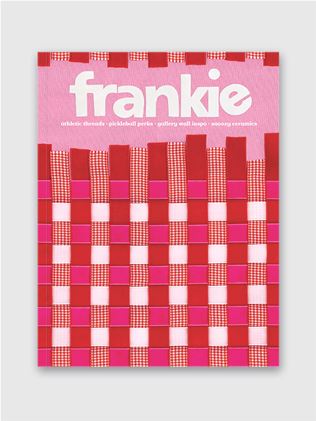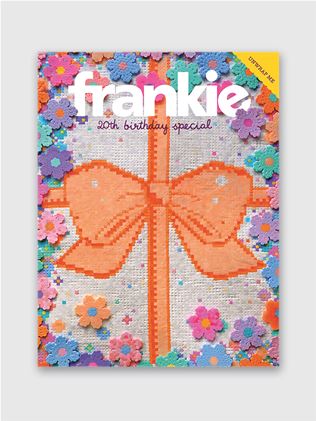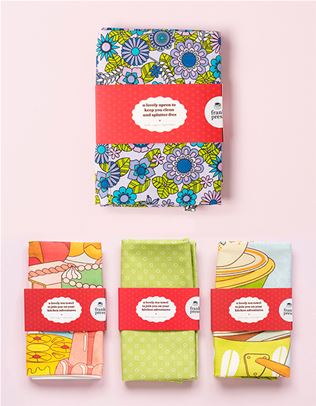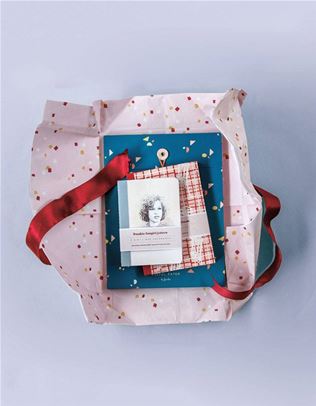a knitwear expert spills the beans on the best ways to take care of your knits
We catch up for a chinwag with Francie founder Anna Woodruff to discuss top-notch tips and tricks for when it comes to looking after your knits.
If you’re an owner of knitwear, you’re no doubt familiar with the plethora of ways a precious knit can lose its shine. From iron burns to too-hot washes, stretched shoulders to shrunken sleeves, it's almost a li’l too easy to ruin a favourite garm. Not to fret – Anna Woodruff, founder of super-lovely knitwear label Francie and someone who has “been living and breathing textiles [her] whole life”, offers her best advice for looking after your knitwear like it’s a first-born child.
LESS (WASHING) IS MORE There are times when it is great to give your knit a hand wash. They might include (surprisingly!) when it is new (this can wash away stray fibres from the knitting process that can lead to pilling later), when it is visibly dirty or has food stains (wash away moth-attracting food stains, particularly before putting your knits away for the summer), or if your knit has stretched (give it a gentle hand wash and allow it to dry in its original shape). AIR INSTEAD Airing out your knit is often all it needs. To level up your airing, you can pop it on a chunky hanger and hang it in the bathroom while you take a shower, or use a garment steamer to refresh your knit with steam.
AIR INSTEAD Airing out your knit is often all it needs. To level up your airing, you can pop it on a chunky hanger and hang it in the bathroom while you take a shower, or use a garment steamer to refresh your knit with steam.
HOW TO SAVE A SHRUNKEN KNIT The hair conditioner method can help! Here is how to do it:
1. Ideally, get onto saving your knit while it is still wet. If it has dried, soak your knit in water until saturated.
2. Remove your knit from the water, then gently stroke some hair conditioner all over the knit.
3. With the conditioner still in your knit, pull the knit apart in all different directions with your hands (you can be tougher than you think). Essentially, you are "detangling" and pulling apart those tightly tangled fibres.
4. Keep stretching as much as you like (or until you think you can no more) then soak your knit in the water and gently rinse it again to remove the conditioner.
5. When all of the conditioner is out, roll your knit in a towel to remove the water.
6. Stretch it out one last time. Allow it to dry flat and as stretched as possible.
Optional extra: When it is dry, steam your knit with a garment steamer or the steam setting of an iron, and stretch again with your hands.
I have saved and improved so many knits with this method, so it is a great one to have up your sleeve. STEAM VS IRON I personally wouldn’t recommend ironing any knits – the risk of burning, melting or crushing your knit with the metal plate of the iron isn’t worth it. But, as you tell, I’m a huge fan of steaming. If I had to choose, I personally would even own a garment steamer over an iron. Almost all knitwear can be steamed – just make sure that if your steamer has a hot metal plate, try to avoid it directly touching the knit. If you don’t have a steamer, you can use your iron as a steamer – just press that steam button and puff steam onto your knit, again making sure not to directly touch your knit.
STEAM VS IRON I personally wouldn’t recommend ironing any knits – the risk of burning, melting or crushing your knit with the metal plate of the iron isn’t worth it. But, as you tell, I’m a huge fan of steaming. If I had to choose, I personally would even own a garment steamer over an iron. Almost all knitwear can be steamed – just make sure that if your steamer has a hot metal plate, try to avoid it directly touching the knit. If you don’t have a steamer, you can use your iron as a steamer – just press that steam button and puff steam onto your knit, again making sure not to directly touch your knit.
KNITS AND THEIR MATERIALS I recommend hand washing for all fibres, and recommend choosing natural fibres when you get a new knit as their naturally antibacterial and odor-resistant properties means you can wear them multiple times without needing to wash. (Smelly polyester from the '70s is famous for a reason!)
STORING YOUR KNITS I love storing my knits with some dried bay leaves or lavender. Either is just as good – it depends on your preference. Moths hate the smell! I personally find that closed storage (like tubs or drawers) is better than open shelving because it’s harder for those little critters to get in. And if they do get in, then they are only in one section – not the whole cupboard! Putting your knits away clean – particularly at the end of winter – also means that moths won’t be as attracted to them. ABSOLUTE MUST-DO Always hand wash a knit that has "gentle cool hand wash" on the tag. We have so many sad folks in our email inbox who have tried to put their knits in the washing machine and ended up with a tiny knit – it’s just not worth it!
ABSOLUTE MUST-DO Always hand wash a knit that has "gentle cool hand wash" on the tag. We have so many sad folks in our email inbox who have tried to put their knits in the washing machine and ended up with a tiny knit – it’s just not worth it!
ABSOLUTE MUST-NOT Don’t be afraid to mend a hole! Mending it badly and quickly is better than putting it off, as any mending stops the hole from getting bigger. Even a “bad” mend can look really charming in my opinion, and you can always undo it and mend it more neatly again in future. MEND YOUR (KNITTED) FRIENDS I think that as more of us learn about the impact of textiles ending up in landfill, we are trying to buy less and buy better quality. (The average Australian throws out 23kg of textiles a year!) A big part of the answer to our textile waste problem is not just making garments sustainably – as we at Francie are trying to do – but also helping people keep their garment for as long as possible, too.
MEND YOUR (KNITTED) FRIENDS I think that as more of us learn about the impact of textiles ending up in landfill, we are trying to buy less and buy better quality. (The average Australian throws out 23kg of textiles a year!) A big part of the answer to our textile waste problem is not just making garments sustainably – as we at Francie are trying to do – but also helping people keep their garment for as long as possible, too.
Mending and repairing can be meditative, creative, and it saves clothing from landfill (and saves money). It’s great that there has been so much interest in our online tutorials and we are so excited to start doing workshops! I think designing responsibly is now more than just about the garment itself. It's also about designing a sustainable life cycle for the garment. For us, sharing these skills is a really important part of that. Anna will be running Francie’s free mending workshop on May 3rd at Francie’s studio in Auckland, New Zealand. No need to stress if you can’t make it – Francie’s journal is chockfull of helpful methods to get your mending underway.
Anna will be running Francie’s free mending workshop on May 3rd at Francie’s studio in Auckland, New Zealand. No need to stress if you can’t make it – Francie’s journal is chockfull of helpful methods to get your mending underway.














.jpg&q=80&w=316&c=1&s=1)













.jpg&q=80&w=316&c=1&s=1)










